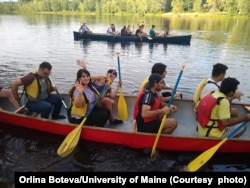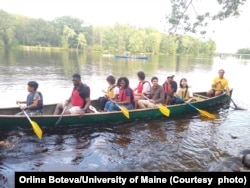The University of Maine Shows How to Increase Its Student Population
The number of students entering college in the US has fallen by over a million since spring 2020. This is when the COVID-19 restrictions went into effect across the United States
Additionally, some US states are finding that they have fewer college-age young people than in the past. Maine, a state in the northeastern United States, next to Canada, is one of those states.
Declining enrollment numbers and the impact of the COVID-19 measures are making it difficult for large public universities to maintain their student numbers.
But while universities in some states are struggling to attract new students, the University of Maine in the city of Orono is not.
A far cry from most other states, Maine has 10 percent fewer state high school graduates than it did 10 years ago.
At a time when fewer Americans are going to college, the University of Maine has increased its undergraduate enrollment by five percent. Why?
A recent story in the publication Hechinger report said the University of Maine is ahead of other states recruitment and retention Dimensions.
The state reduces university tuition for students coming from other states and Canada. Through grants and other financial aid, many students can go to Maine for the same price as a major university in their own state.
For example, the University of Maine advertises in nearby Massachusetts. The ads say, “Go to the University of Maine for the state expense of UMass.” UMass stands for the University of Massachusetts.
The university has about 12,000 students. While that seems like a lot, it’s not nearly as many as large schools like Ohio State University, which has about 60,000. As a result, the school seeks to create a strong connection with both current and others prospective Students.
University leaders say they try to get to know all the students they visit — even those who decide to go elsewhere.
Chris Richards is Vice President of enrollment Management. He said the school needs help from everyone to recruit the next class of students, not just the people who work in the admissions office. That was the old way.
“This model,” he said, “will no longer work.”
Part of the new method is for university professors and researchers to give presentations about their work at nearby high schools. Another is to make visitors feel welcome.
Richards described how he helped settle someone who seemed new to the school grounds. “People want that,” Richards said.
Em Jeffrey is a new student from the nearby state of New Hampshire. She said she noticed the difference between going to Maine and going to other schools.
“I definitely felt more welcome. None of it felt forced,” she said.
Jerome Lucido is a college matriculation student at the University of Southern California School of Education. He said the University of Maine is on the right track.
“I think there are lessons from what’s going on in Maine right now,” he said.
Richards said his university recognized the problem about 10 years ago, when Maine’s high school student population began to decline. In the past, 80 percent of the university’s students were from Maine. Around 40 percent now come from other federal states.
In addition, there are over 450 international students in a degree program at the University of Maine. Other international students participate in the school’s program for English learners.
Orlina Boteva is Director of International Programs. She grew up in Bulgaria and came to study at the University of Maine. She has finished postgraduate is doing his doctorate and has been working with international students since 2009.
She said that international students interested in the University of Maine would have to pay similar costs as students from other states in the US, but the university offers it grants from $5,000 to $20,000. In addition, the university offers teaching assistant positions for doctoral students.
Boteva said her department does nothing differently than other schools in the Northeast US to attract international students.
However, she said the university’s goal of connecting with students extends to those from outside the United States as well. University officials travel to other countries to find students and meet their families. They even made some visits last year when other universities did not send their representatives abroad. The university also tries to ensure that international students feel comfortable when they come to Maine.
“Our population is small enough for us to get to know our students. They have a really outstanding experience on campus… So this experience really adds up to a very high rating of the student experience on campus as an international student.”
As a former international student, Boteva said the experiences that students from other countries have while in Maine are “very important” to her. She also wants students to know that it is possible to find out how to get a work visa and stay in the US after completing a degree.
Boteva said the school also pays attention to students coming from countries with economic difficulties. The US dollar is much stronger today than it was a year ago. That means it’s more expensive to go to an American school. Boteva said the school will work with students who are already there but may have trouble paying.
Additionally, the University of Maine just announced that it will be changing the tuition fees for students coming from a war-torn country like Ukraine. They now pay the same amount as students coming from Maine. That means a big saving.
“This is really the first time we, as an institution, are looking at what is ours missionas an institution to support students displaced by war.”
She said the school is considering how to help students find a path to education when their countries become destabilized. This year, eight students from Ukraine are attending the University of Maine.
There is no guarantee that current ideas will work in the future. However, Richards said he believes the university will continue to work to address the problem of declining student numbers. He said the university management recognizes the problem.
“The good thing for us,” he said, “is that our leadership didn’t do that existed in a vacuum the false reality.”
I’m Dan Friedell.
Dan Friedell adapted this report for Learning English based on a story from The Hechinger Report, a nonprofit, independent news organization focused on inequality and innovation in education.
__________________________________________________________________________
words in this story
recruit -v. Find people who are qualified to join a group or organization
retention -n. the act of keeping someone in a job or in school
scholarship -n. an amount of money made available to a student by a school, organization, or individual to pay for the student’s studies
prospective – adj. might become something in the future
enrollment -n. the act of becoming a member or participant in something
postgraduate – adj. in relation to school achievements that are provided after graduation
mission -n. a task or task assigned to someone
destabilized – adj. be so impaired that normal continuation is no longer possible
exist in a vacuum -Idiom to exist in a state unaffected by other influences; totally separate and independent
__________________________________________________________________________
We want to hear from you. Would you consider going to school in Maine?
We have a new comment system. Thats how it works:
- Write your comment in the field.
- Below the box you will see four images for social media accounts. They are for Disqus, Facebook, Twitter and Google.
- Click on an image and a box will appear. Enter the login for your social media account. Or you can create one in the Disqus system. It’s the blue circle with the “D” on it. It is free.
Each time you come back to comment on the Learning English site, you can use your account and see your comments and replies to them. Our comment policy is here.


